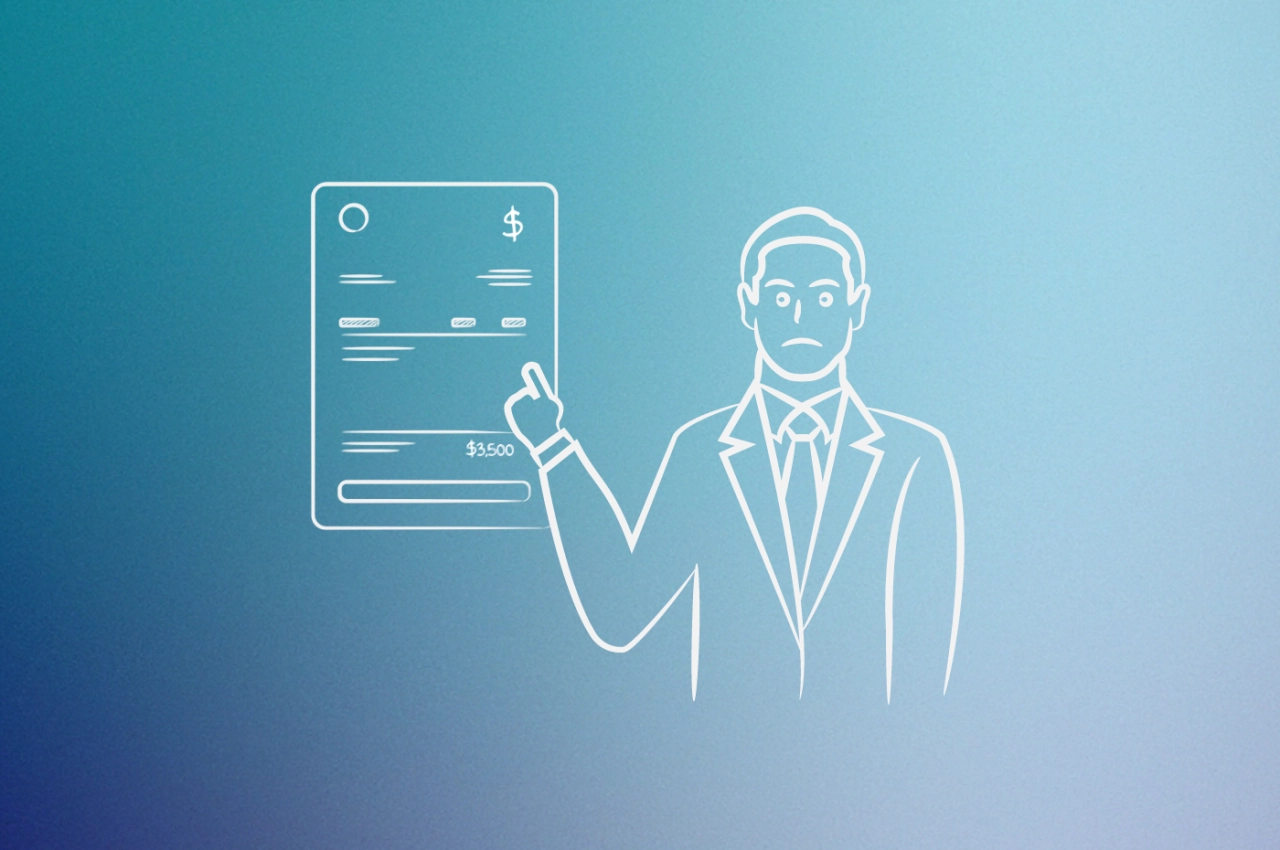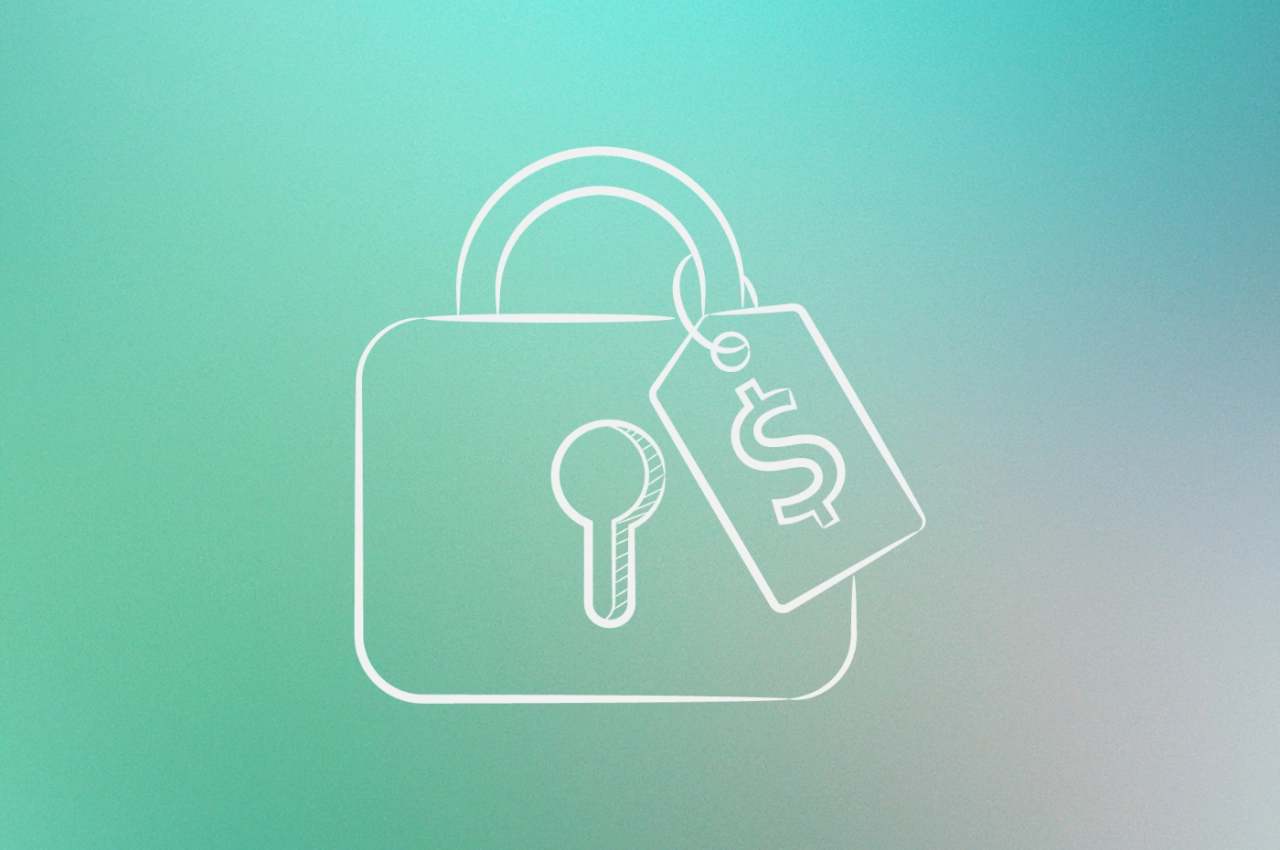Value based pricing is one of the more difficult strategies to pull off. To be successful, you need to do market research, check competitors, and understand your customers.
A perfectly thought-through agency pricing model will help you scale your digital agency in a matter of months. At SPP, we’ll get into the intricacies behind value-based pricing and best practices that you can adopt in order to grow your business to the next level.
What is value-based pricing?
When business owners follow the value-based pricing strategy, they set prices for a product or service based on the projected value it uniquely offers to customers. This is in stark contrast to other strategies where you take into account profit margins, labor, or historical and competitor prices.
Keep in mind that your company’s core values should be represented in your pricing strategy. Also keep the perceived value in mind because there’s a limit to how much your target group is willing to pay.
Value-based pricing example scenarios
Since the price is a numerical evaluation of how much a customer values your offering, you need to consider what is most important to them. This, of course, will depend on your niche and offering. Let’s go over a handful of examples of this in action.
Video editing: determine the purpose of the video. If you’re creating or editing content strictly for brand awareness, it may not be as valuable compared to crafting a video to convert prospects. As a video editing agency, it’s important to sit down with the client and find out what their goals are.
Graphic design: where will your creations be used? Is it for a simple blog post, one-off advertising campaign, or is the company planning to rebrand their entire product line with your new design? Each scenario will respectively warrant a higher price tag because your graphic design becomes more critical to the client and their business.
Podcast creation: are your services aiding the client’s supplementary content marketing channel (e.g. ZipRecruiter’s Rise and Grind podcast), or is the podcast the core of their business (like Joe Rogan)? If your services have a higher degree of impact on the client’s revenue, then the client will want to feel like they’re hiring top-notch talent for the job—and you can make them feel that way with premium pricing.
Social media management: most brands today have a social media presence. But you shouldn’t base your rates on that minimum requirement. Ask questions about how the client wants to leverage their social channels. Do they want to just look alive, build credibility, or is their community engagement crucial for recurring revenue? This tells you exactly how much they value social media efforts, and how much you can charge accordingly.
Reputation management: brand image is important to every company, obviously. But some companies will need a greater emphasis on credibility and trustworthiness. For example, organizations related to health care or finance cannot afford to lose face; or production companies that make essential items. Evaluate the degree of importance of a good reputation for your prospect and start charging higher.
In the following sections, we’ll dive deeper into some actionable strategies for basing your prices on value and personalizing your offers for different customers.
Types of value-based pricing
There are several types of value-based pricing strategies, but two popular approaches are good value pricing (GVP) and value-added pricing (VAP).
Good value pricing
Good value pricing is a strategy focused on identifying the unique benefits your agency offers clients. It involves understanding what distinguishes your agency from competitors and using those strengths to deliver tangible results.
Key characteristics:
focuses on the client’s needs, pain points, or goals
emphasizes the value of expertise, experience, and specialized knowledge
often involves a more consultative approach
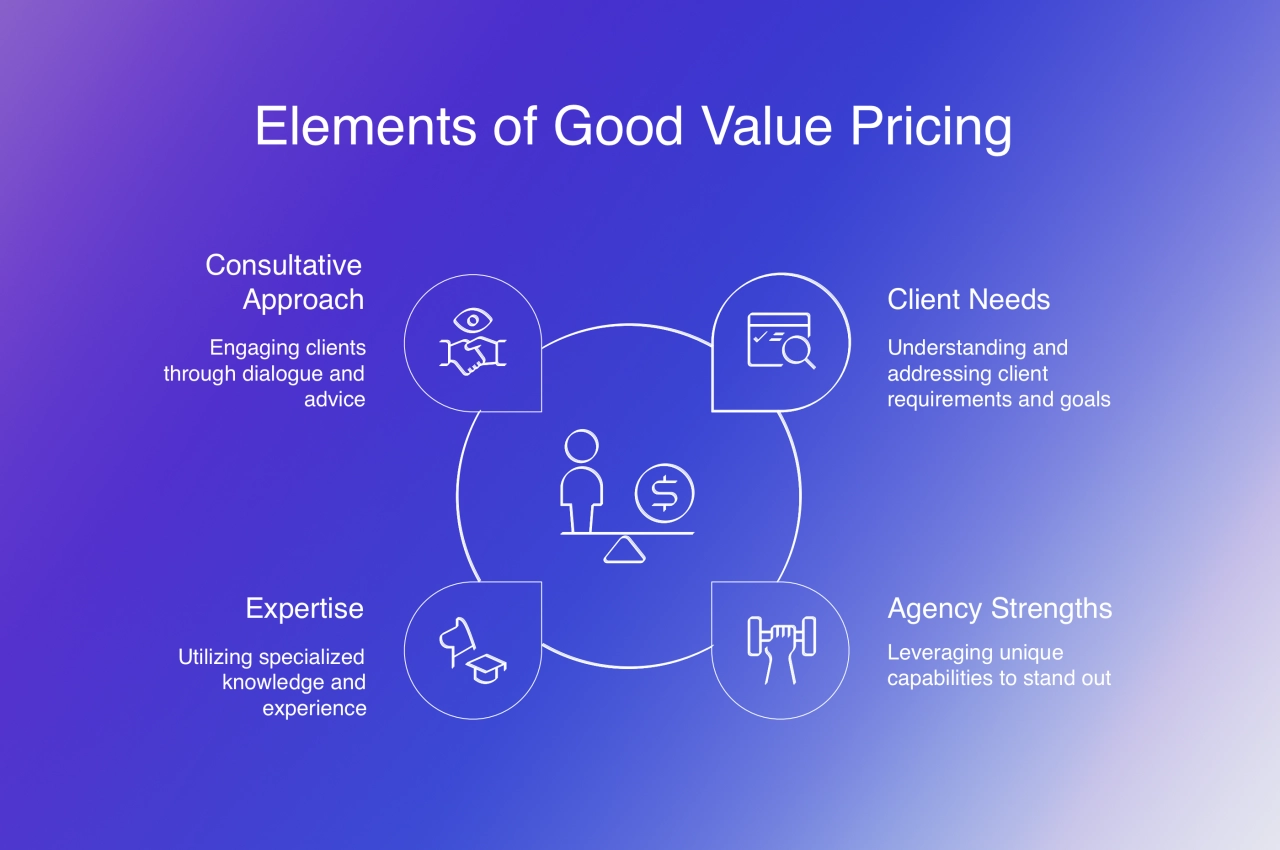
Example:
A digital marketing agency discovers that their clients face challenges with social media engagement. To address this, the agency creates a tailored strategy that encompasses regular content creation, influencer partnerships, and analytics-driven insights to enhance their clients' online presence.
Value-added pricing
Value-added pricing goes beyond just identifying benefits by quantifying them in terms of tangible results or outcomes. This method requires agencies to provide clear metrics, benchmarks, and ROI projections to showcase the value they offer.
Key characteristics:
focuses on measurable, data-driven outcomes
emphasizes the agency’s ability to drive real results for clients
often involves a more collaborative, partnership-oriented approach
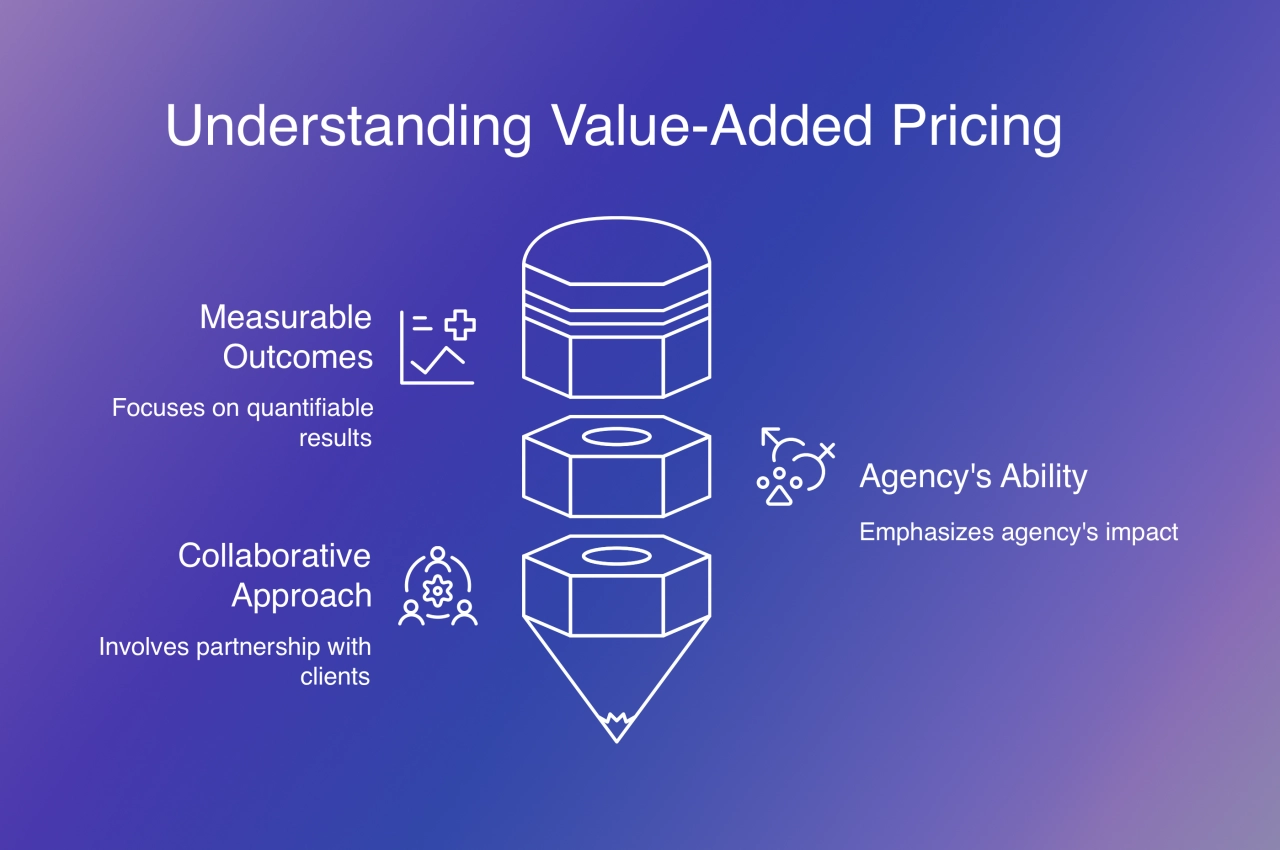
Example:
A web design firm undertakes a website redesign project that encompasses visual enhancements, improved user experience (UX), increased search engine optimization (SEO), and enhanced e-commerce functionality. The client agrees to a flat fee based on the anticipated increase in sales, such as 10% within six months, and the revenue generated.
Developing a value based pricing strategy
Why are experts charging too little for their services these days? Because
a) they’re trying to compete on price and
b) they use cost based pricing.
There’s no point trying to compete on price, unless you are the cheapest provider in the niche, bar none.
If you decide to go down this route, know that there will always be someone who’s willing to work for less.
Cost-based pricing means you set the price based on labor costs and materials. It works for Ryanair and Walmart, but certainly not for a small agency. Pricing services this way is about as effective as a cat door in an elephant house.
On the other end of the spectrum are premium companies, such as Apple. Let’s discuss why they’ve chosen their pricing based on the value of a product.
Clearing misconceptions about value-based pricing
Value-based pricing may be incredibly popular in various industries, but many marketers have some big misconceptions about how the process works. Here are the top three:
Value-based pricing isn’t about a customer’s willingness to pay for every feature: Don’t add up each feature’s value for a final price. Many competitors offer similar perks, calculations can get complex, and customers don’t evaluate every detail. Focus on differentiators and customer valuation. For example, a cold outreach agency might price based on projected conversions rather than the number of email accounts contacted monthly.
A brand’s value need not be included in value-based pricing: Marketers should assign a dollar amount to unique features that add value, like faster service by X%, longer-lasting results, or a proven growth plan.
Value-based pricing fails if competitors price unreasonably: You can’t ignore competitors’ prices and solely rely on value-based pricing to grow your digital marketing agency. Competitors’ prices affect perceived value. If they charge much less for similar services, justifying higher prices is difficult. Determine your differentiation and its worth to customers.
The 5 advantages of value based pricing
While value based pricing is hard to set up, the long term advantages outweigh the disadvantages:
Thanks to a detailed competitor analysis, you’ll enjoy higher profit margins.
The competitor research can help you focus on more lucrative products/services.
You learn new things about your target audience, competitors, and the overall market.
Value based pricing is more strategic than the cost based alternative. This allows you to better plan your marketing strategies.
You’ll be able to accurately estimate the demand for your product/service which helps you create a proper supply channel, price and market it accordingly.
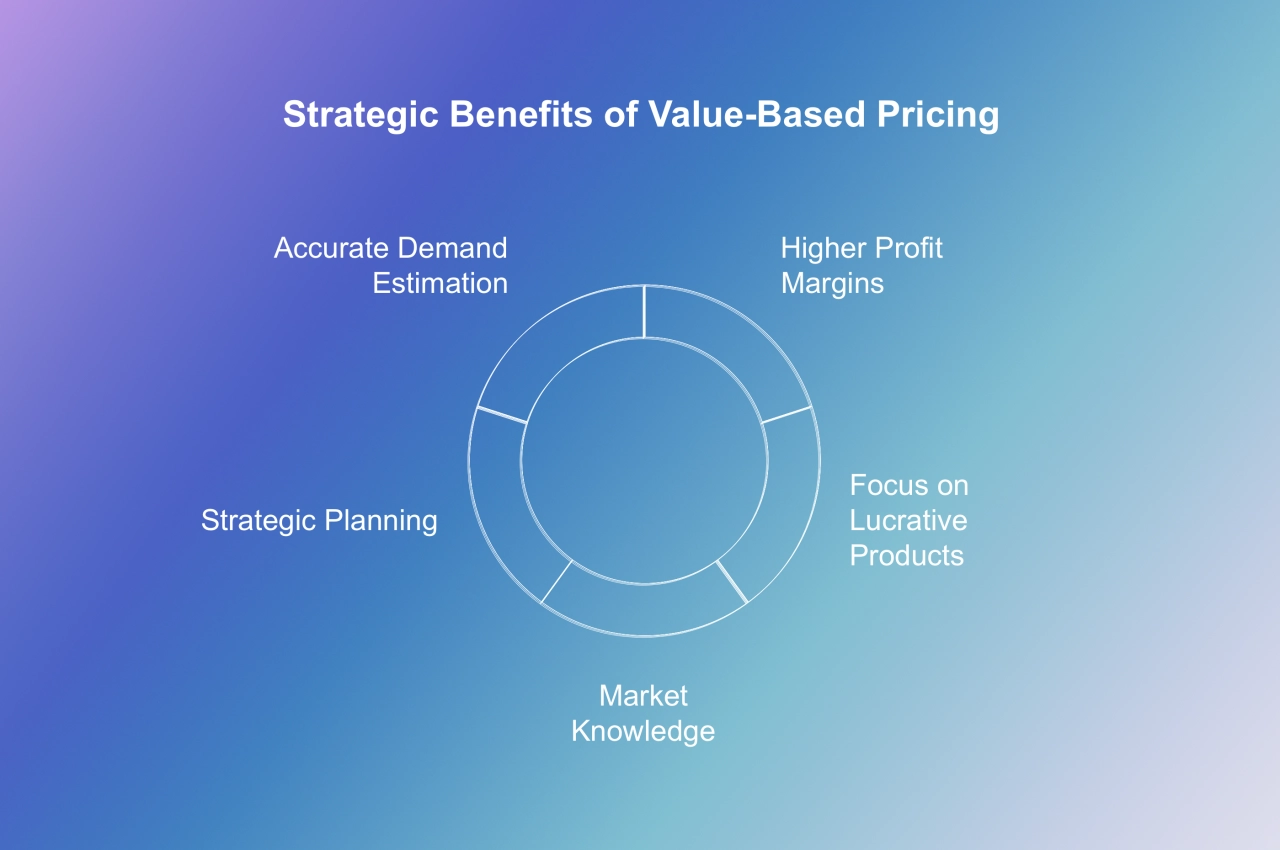
Naturally, there are also disadvantages to the value based pricing method:
Depending on your niche, the demand might be very low for your product or service. If new competition arrives, you’ll have to position yourself even better.
You’ll need to put a lot of time, effort, and resources to implement a value-based pricing strategy. This is often an issue for those who are getting started.
This business method works well for small businesses who focus on a specific service or product. It’s very hard to scale for larger companies.
Value based pricing vs. cost based pricing
The value of a service depends entirely on the client, the size of their business, if they have niched down, and their unique situation. Cost-based prices, again, revolve more around your business costs and stay true to a specific profit margin.
To determine how valuable your expertise is, you need to check what kind of clients are you working with:
Business owners who want to get noticed, but don’t know how
Marketers who know SEO basics, but can’t do it themselves
SEO resellers who work with the first category above
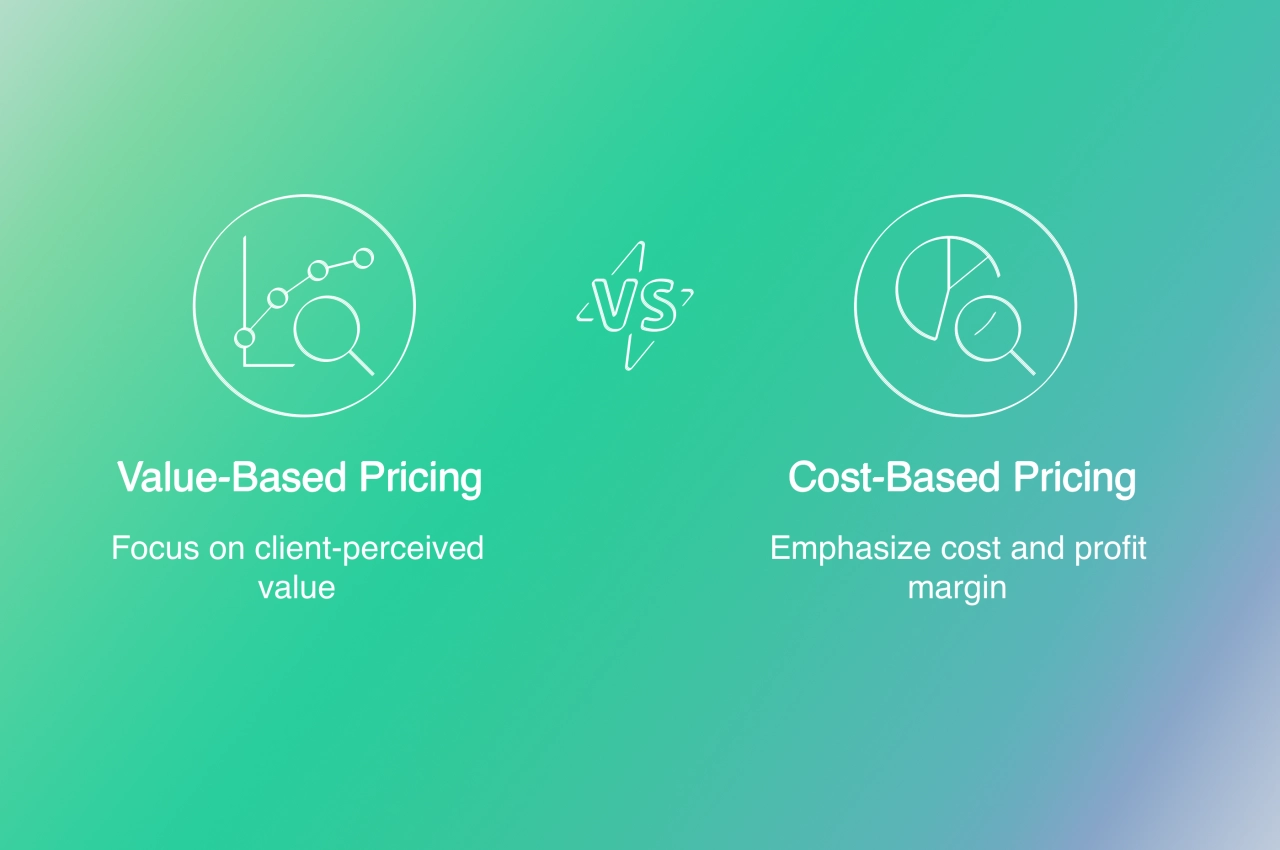
It’s a best practice to determine your pricing for a single segment of customers. The reasoning is simple: different segments of customers will have different perceptions of value toward your product or service.
A small business owner will benefit more from your experience than a reseller who’s looking for somebody to do the manual work. A reseller can buy a service for pennies on the dollar and sell it to the right client for a lot more.
Competition based pricing is a bad idea
There’s nothing wrong with checking out the competition. A competitor analysis is a good way of finding your way around a niche. However, you shouldn’t copy-paste a competitor’s price to your own offering if you’re not offering anything worthwhile.
While this might work in the gasoline industry, how are you going to set yourself apart with your content marketing offer? Unless you can outsell the competition with a good value proposition, your chances will be slim.
And that’s the reason why a bit of smart marketing combined with value-based pricing can help.
Determine the next best alternative that your specific target market would have if you didn’t exist. This will be the essential point of comparison for calculating a value-based price. Once you understand the differentiated worth of your product or service’s unique features to the customer, you can place a dollar value on it.
For example, if your SEO writing agency also offers backlinking services unlike other SEO services, then you can justify the higher-order value in your bundle. That’s the only competitor-based pricing strategy that makes sense.
Packages or custom quotes?
Our research has shown that the top ranked SEO agencies do not display their pricing online. We looked at agencies ranking for terms “seo agency” and ignored a few agency comparison sites.
These general search terms are bringing in a wide range of prospects: from individuals to big businesses. Naturally, they want to be quoting each client based on the size of their business and the value the client will be getting.

If you’re selling through a single medium (like forums), you can attract a lot of similar clients. In this case package pricing makes sense, because you can predict how much value your average client will receive.
Creating a sales funnel
Expensive services are often sold over the phone or in person. It makes sense to close them this way if the value is large. Clients need that extra attention, and at that price point you can afford to give it.
This is what we are doing at SPP as you can see on our pricing page:
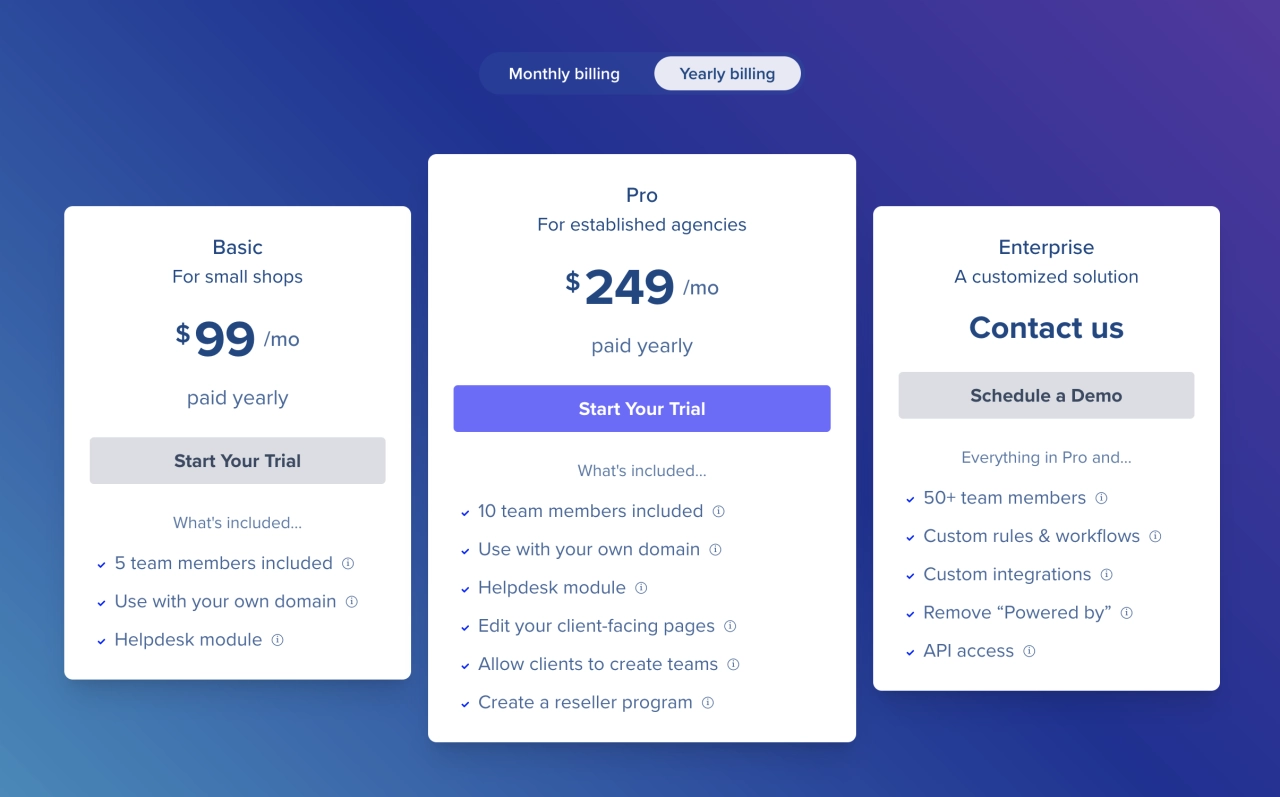
We offer two different plans with a discount for yearly payments. Our enterprise plans are custom tailored, so we ask potential leads to either email us, or schedule a call.
This allows us to capture potential leads, research them, and create a valuable proposition. You can also use the opportunity to put leads into a sales funnel and use targeted email marketing to convert them.
Offering discounts to old & new clients
If you’re known for giving discounts left and right, people will always expect you to do so. These clients typically need excessive hand holding and are more trouble than they are worth.
Sometimes they even promise to bring you a lot of business if only you do this one gig for free. In clients’ eyes a free service is not as valuable as one they’ve paid full price for. This introduces a whole set of problems in the client-professional relationship.
One way around this scenario is to offer a free trial period (for recurring services) instead. Or, a cheaper one-time service that serves as a preview. It should be convincing enough that anyone interested in your service becomes a long-term client.
On the other hand, nothing prevents you from creating coupons for specific events that you can focus your marketing efforts on. Be it Black Friday, Christmas, or any other holiday–coupons remain a good marketing opportunity for any agency.
Instead, think about setting up a referral system through SPP.co. Those who bring in new clients will be rewarded.
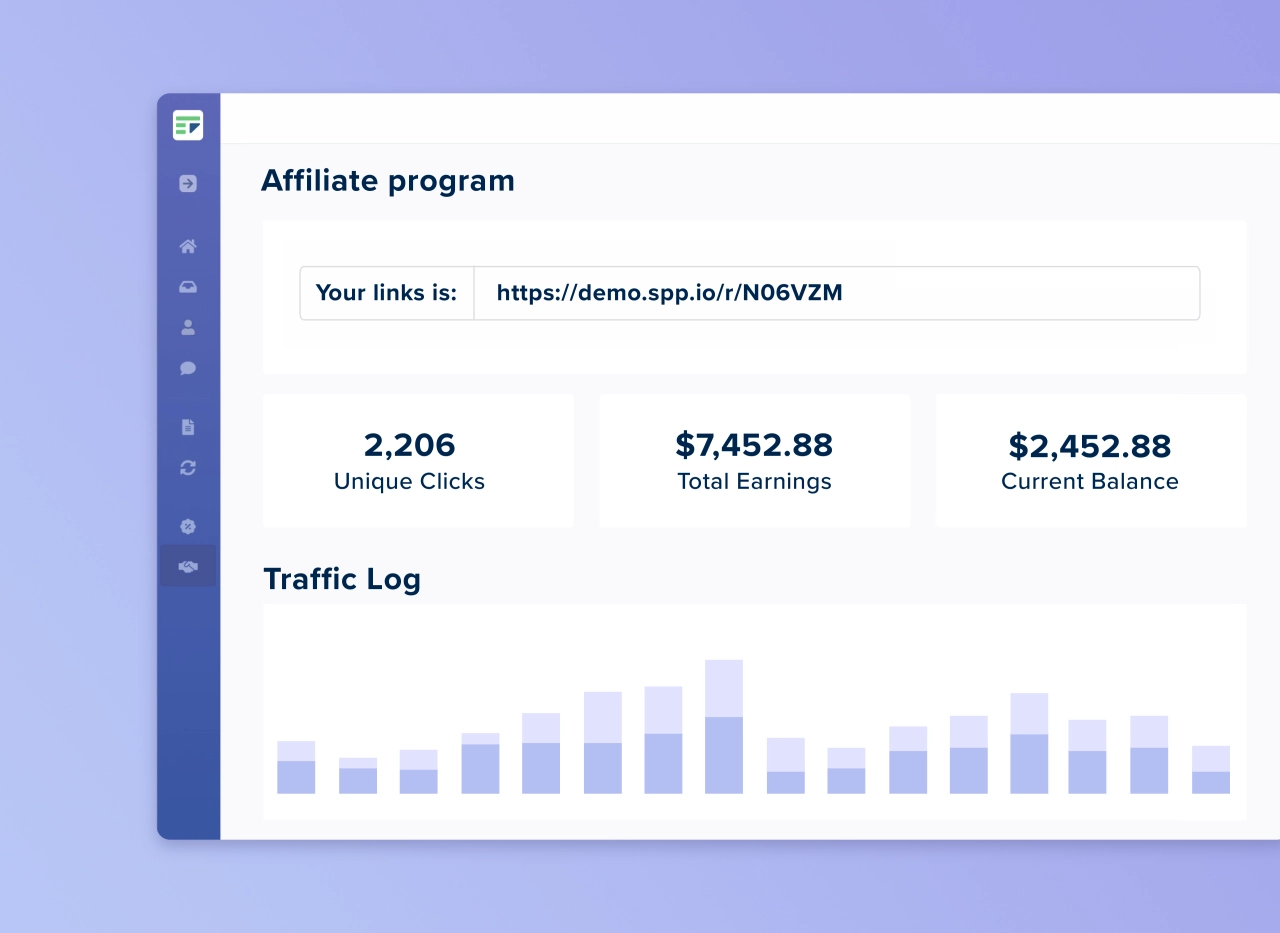
Convert your clients into brand ambassadors.
Depending on your setup, you can offer commissions on all sales, or restrict it to a certain period of time.
Create service bundles
As a digital agency, you know both your company and target audience very well. Analyze your current services, and think about a way to bundle them together.
Here’s an example:
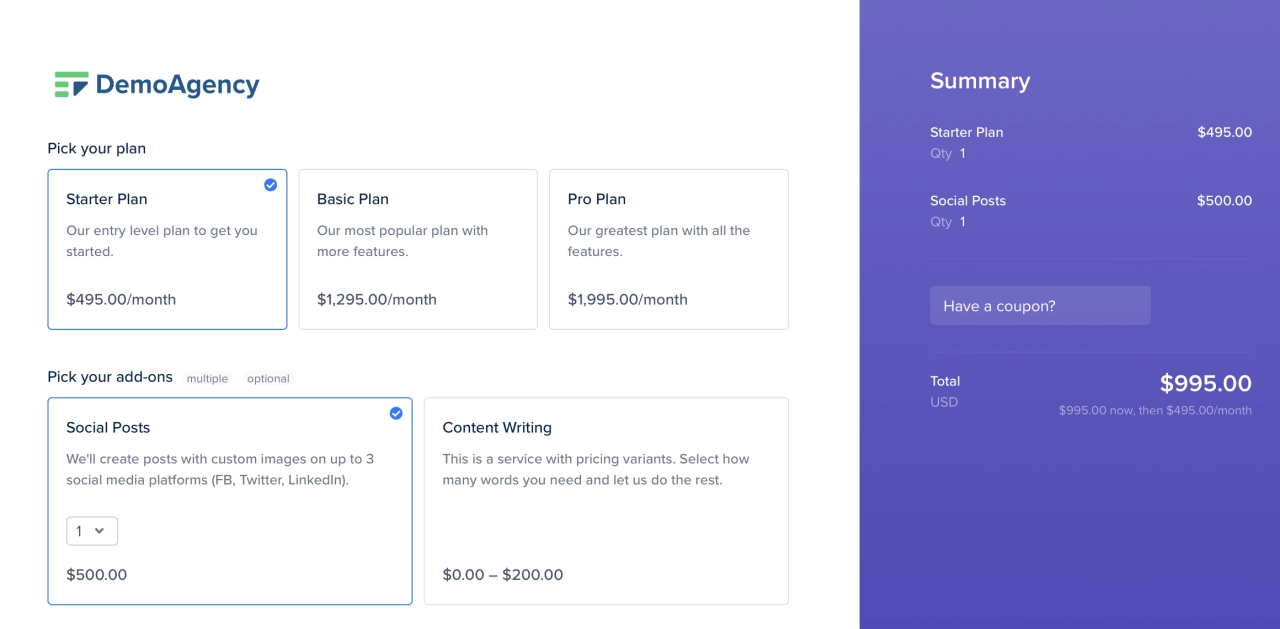
Assuming you are selling monthly content marketing plans, why not offer blog writing and social media posts too? SPP.co allows you to design your order forms any way you like.
In the above example, a client can add extra services to their subscription if they are interested. Use the flexibility of order forms to also ask your clients a question. Identifying crucial pain points helps you offer better services.
3 psychological pricing methods worth trying
These are some pricing gimmicks you can test to give your conversion rates a quick boost. Here are some of my favorites.
1. Magic number pricing
The reason “marketing gurus” price things ending with 7 is because everybody else is doing it. It’s the industry norm and if you want to be associated with that industry, go ahead and price your services at $7.
There are also studies about prices ending in 9, also known as left-digit bias. According to More than a Penny’s Worth: Left-Digit Bias and Firm Pricing, buyers perceive a price such as $49.99 as much lower than $50.00, at least in the retail industry.
2. Round prices
According to this study, 42.9% of respondents believe round prices are more honest and communicate higher quality. This stands true for high ticket services, which are often priced at round numbers like $500 or $5,000.
3. Price anchoring
When making decisions, humans have a tendency to rely too heavily on the first piece of information offered.
Most service focused companies seem to use the 3-option pricing strategy quite often–we use it too! The reason is simple, humans are wired to think in threes:
We order drinks in small, medium, or large sizes, and
Focus on jewelry made of gold, silver, and bronze.
In pricing we can use a first, higher price as an “anchor” indicating the actual value of a service. We can then show a lower price, which seems smaller in comparison.
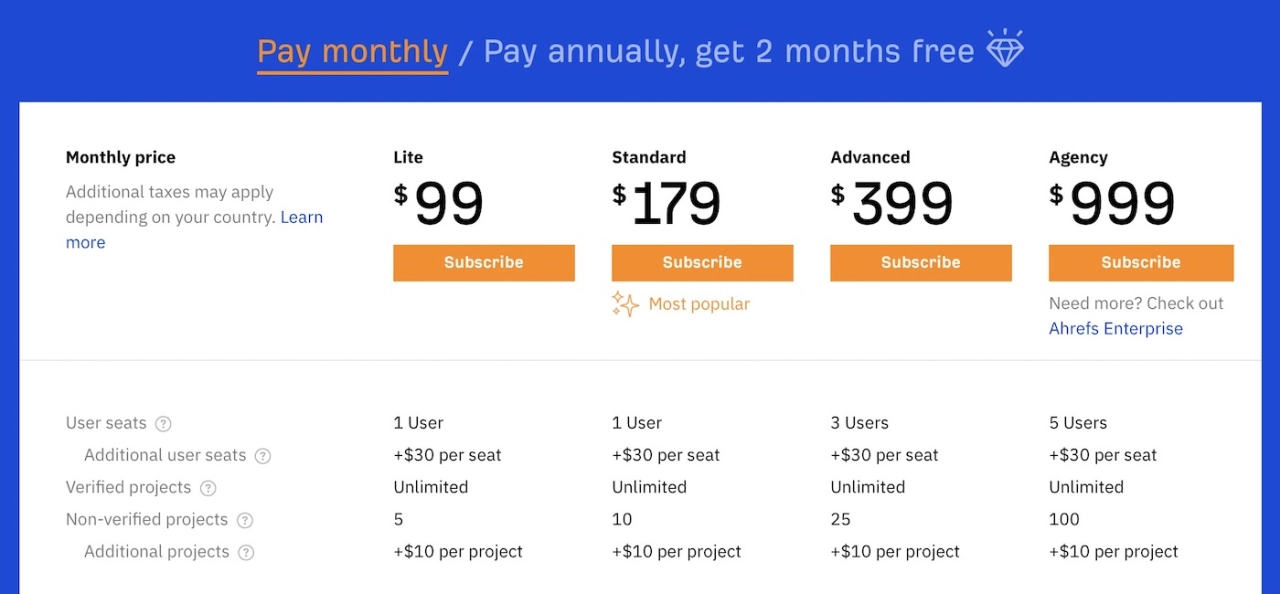
Add one more higher level tier to your pricing grid. Even if nobody buys it, it’ll make other tiers seem cheaper in comparison.
Ahrefs shows on their yearly pricing page that the Standard plan is the most popular.
Once you start looking at the comparison table on the ahrefs.com pricing page, you’ll notice how good a deal the standard plan is.
Key takeaways
The main takeaway: charge based on the customer’s perceived value not how much labor it requires on your part. Learn who is buying your services and how much value they’re getting out of them.
If catering to a broad market, price projects individually. Use package pricing in narrow markets. Avoid pointless discounts and try to work with people who value your expertise.
Pricing things with sevens can make you seem like one of those fake gurus. Nines are a safer bet, while zeros communicate high quality and fair pricing.
Ultimately, don’t do things just because everybody else is doing it. Do your tests and blaze your own path.


